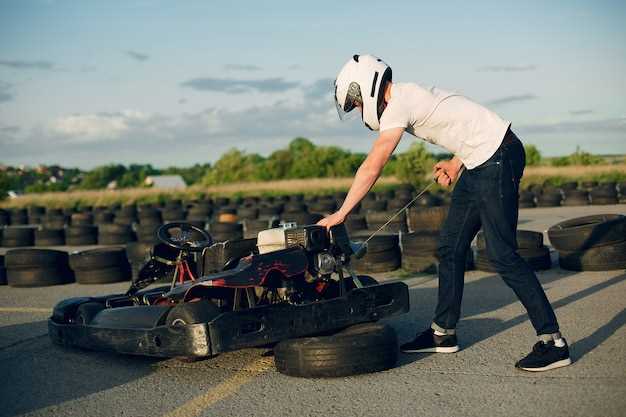How Drivers Handle Pressure at VW Motorsport

In the high-stakes environment of motorsport, the mindset of a driver can significantly influence their performance on the track. The ability to manage pressure not only distinguishes successful racers from their competitors, but also plays a crucial role in ensuring consistent results throughout the season. For VW motorsport drivers, mastering this aspect involves a combination of mental fortitude, strategic planning, and rigorous training.
Every race presents a unique set of challenges, and drivers must navigate various forms of pressure–be it from competitors, team expectations, or personal ambitions. The most accomplished VW drivers employ specific strategies to maintain focus and composure, transforming potential stressors into motivating factors. Understanding the psychological dynamics of racing allows them to perform at their best, even in the most challenging situations.
Moreover, these pressure management strategies are built upon a foundation of experience and continuous learning. Drivers leverage insights from past races, adjust their mental approaches, and implement techniques designed to enhance concentration and resilience. This article explores the methodologies adopted by VW motorsport drivers, highlighting how their mindset shapes their racing success and contributes to their evolution as athletes.
Techniques for Handling Race-related Stress During High Stakes Competitions

In the high-pressure environment of motorsport, drivers often face intense stress that can affect their performance. Developing effective techniques to manage this stress is crucial for success on the race track. One of the primary strategies involves cultivating a resilient mindset. Drivers are encouraged to focus on process-oriented goals rather than solely on outcomes. By prioritizing their performance in specific aspects, such as cornering and braking, they can reduce the overwhelming weight of expectations.
Visualization techniques also play a vital role in handling race-related stress. Before a race, drivers can mentally rehearse their performance, visualizing the track, their actions, and the expected challenges. This mental preparation helps to create familiarity and reduces anxiety. Additionally, incorporating breathing exercises into their routine can significantly lower stress levels. Deep, controlled breathing techniques can help drivers regain composure, especially in high-stress situations during a race.
Another key technique is the establishment of a pre-race routine. A consistent routine helps to create a sense of normalcy and control, allowing drivers to focus their minds. This can include specific warm-up exercises, engaging in light conversations with team members, or listening to particular music. Furthermore, physical fitness cannot be overlooked; regular exercise enhances overall resilience and supports mental clarity, ultimately helping drivers cope with stress more effectively.
Finally, maintaining a strong support system is vital. Open communication with team members, coaches, and psychologists can provide drivers with the emotional support they need during high-stakes competitions. Sharing their thoughts and feelings about stress can lead to valuable coping strategies and enhance overall performance. By employing these techniques, drivers can manage race-related stress and maintain optimal performance under pressure.
Mindfulness Practices Adopted by Drivers to Maintain Focus Under Pressure

In the high-stakes world of motorsport, maintaining an optimal mindset is crucial for drivers to perform at their best, particularly during intense situations. Mindfulness practices have emerged as effective tools that help drivers manage stress and enhance focus, allowing them to navigate the demands of racing more effectively.
One key practice adopted by drivers is the implementation of breathing techniques. By concentrating on their breath, drivers can alleviate feelings of anxiety and regain composure during races. Controlled breathing helps lower heart rates and minimizes stress, enabling drivers to concentrate on their performance instead of external pressures.
Visualization techniques are also common among drivers. This involves mentally rehearsing various scenarios they may encounter on the track. By visualizing successful outcomes, drivers can cultivate a positive mindset that reduces stress and boosts confidence. This mental imagery fosters a sense of preparedness, making it easier to react calmly under pressure.
Another significant aspect is the practice of staying present. This involves focusing solely on the task at hand and avoiding distractions. Many drivers use techniques like body scans to ground themselves in the moment, which helps to manage racing-related stress. By recognizing their physical sensations and maintaining awareness of their surroundings, drivers can enhance their decision-making ability during critical moments.
Finally, mindfulness rituals, such as daily meditation, have been integrated into training regimens. These practices encourage drivers to cultivate resilience and emotional regulation. Regular meditation enhances their ability to deal with stress, allowing for clearer thinking and improved focus during races.
Overall, the adoption of mindfulness practices equips drivers with the necessary tools to maintain a focused mindset under pressure. By effectively managing stress through these strategies, they can optimize their performance and ensure a competitive edge on the racetrack.
Analyzing the Impact of Team Dynamics on Driver Mental Resilience
The dynamics within a racing team significantly influence a driver’s ability to manage stress and maintain mental resilience during races. Each member of the team plays a crucial role, from engineers to pit crew, and their interactions can either support or undermine a driver’s performance. A cohesive and positive team environment fosters trust and communication, essential elements for alleviating race-day pressures.
When team dynamics are strong, drivers can focus better on their performance rather than external distractions. This support system allows them to approach races with a more confident mindset. Conversely, dysfunction within a team can heighten stress levels, leading to doubts and anxiety that can negatively impact race outcomes.
Effective communication is a critical component of healthy team dynamics. Regular updates and feedback among team members enable drivers to quickly adapt strategies during races. This adaptability is vital when confronting unexpected challenges, as it enhances a driver’s capability to remain calm and composed under pressure.
Moreover, psychological support from teammates can significantly boost a driver’s mental resilience. Knowing that they have the backing of a strong team can instill a sense of security, making it easier for drivers to navigate high-stress situations commonly encountered during races. A supportive environment can provide vital encouragement, allowing drivers to push their limits while managing stress effectively.
In summary, the interplay between team dynamics and a driver’s mental resilience is profound. A well-functioning team can help reduce stress and foster an atmosphere where drivers can thrive. As such, focusing on building robust team relationships should be a priority for motorsport organizations aiming for success on the race track.



